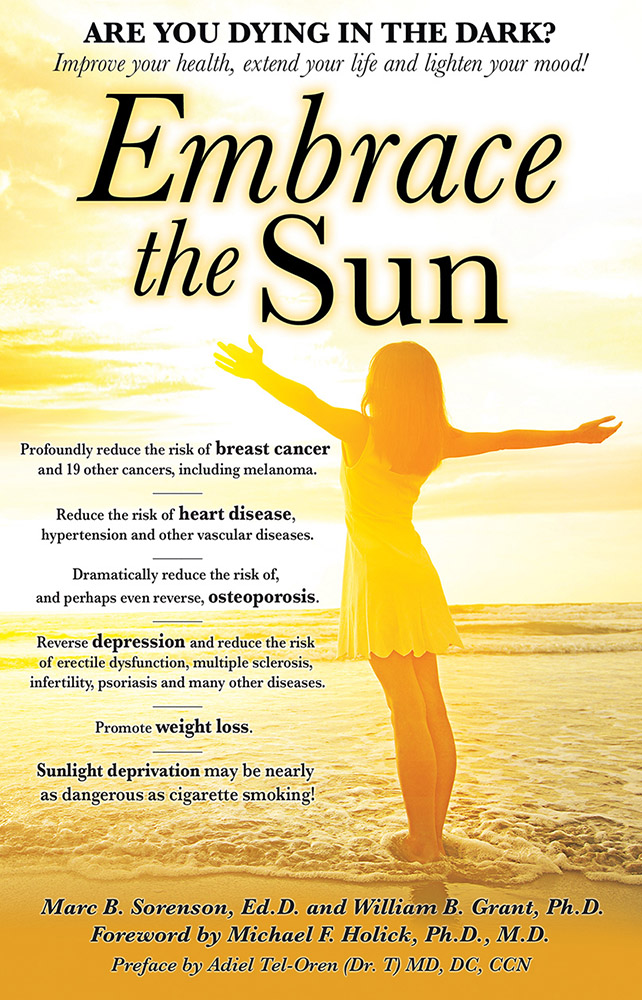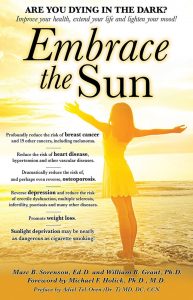Vitamin D, prostate cancer and sunlight By Marc Sorenson, EdD
Vitamin D is a magnificent, critically important photoproduct of sun exposure, sun lamps and sunbeds (tanning beds). It is not really a vitamin, but rather a hormone that controls hundreds of genes in the body. The production of this hormone occurs in the skin in response to UVB light from the aforementioned sources. About 90% of vitamin D blood levels, across the average population in the U.S., occurs through sun stimulation to skin. Supplements and food sources provide only a small amount of vitamin D on average.
Vitamin D and other cancers, including prostate cancer (PC)
There is a close association of high vitamin D levels and lowered risk of breast cancer and many other cancers. Therefore, it seems logical that supplementation might also reduce PC risk. However, it seems like that may not be the case, and it needs further discussion. In fact, vitamin D studies show only weak correlations between vitamin D levels and a reduction in PC. The highest levels of serum vitamin D shows a J-shaped curve, meaning those levels actually associated to a slightly increased risk. No such increase occurs with the highest levels of sunlight exposure–quite the opposite. The highest levels of sunlight associated to the highest levels of protection against PC.
An interesting study on sunlight, vitamin D and prostate cancer.
It was with interest, therefore, that I read a recent article describing the effect of sunlight on PC, called “Sunlight could decrease prostate cancer risk.” After affirming that sunlight exposure could reduce the risk of PC by 50%, the author unfortunately stated, “This does not mean men should deliberately sunbathe to reduce their risk of prostate cancer. Outdoor exercise and an adequate amount of vitamin D from diet should be sufficient to afford protection from the disease.” Yet, this is not a statement based on science, especially considering the J-shaped curve. Thus, the author obviously assumed vitamin D caused the association of sun exposure to reduced PC risk.
Now, let’s talk about some impressive studies on sunlight per se.
Here are some rather interesting studies regarding sun exposure and PC. In addition, there are numerous others discussed in the book, Embrace the Sun. Probably the most stunning paper was one in which researchers used childhood sunburn as a measure of sun exposure. As a result, they determined that men who experienced sunburns as children were protected against PC. Consequently, they had one-fifth the risk of contracting prostate cancer as those who had not sunburned! However, please do not burn!
Let us be careful about our sunlight!
In addition, a note of caution regarding sunburn: I do not recommend that anyone sunburn to prevent prostate cancer. The researchers used sunburn to predict higher vitamin D levels. Yet, sunburn is not necessary to achieve the remarkable results, since non-burning sun is sufficient. Most noteworthy, this research also demonstrated that men with the lowest sunlight exposure had more than three times the risk of prostate cancer. A follow-up to this study was also interesting. Men in the lowest quartile of sunbathing had a 5.3-fold greater risk of prostate cancer compared with men in the highest quartile.
A final thought
One more paper, cited in conclusion. Researchers have stated, “Higher levels of cumulative sun exposure, adult sunbathing, childhood sunburn and regular sunny holidays in hot climates were each independently and significantly associated with a reduced risk of this [prostate] cancer.”
Men, protect your prostate by obtaining plenty of non-burning, regular sun exposure.
For more information on myriad positive sun articles, visit http://sunlightinstitute.org/ and read the book, Embrace the Sun, by Sorenson and Grant.
Sunlight and Cancer. By Marc Sorenson, Ed.D

Sunlight and cancer are subjects that are misunderstood by most of the populace, and the press. Furthermore, sunlight and cancer are believed by most to have a cause and effect relationship. Thus, sunlight exposure to humans is thought to be dangerous and deadly, and is deemed carcinogenic by many health organizations. Yet, the research continues to indicate that sunlight and cancer have an entirely different relationship than the pundits propose. Let’s examine and comment on important sunlight and cancer research that belies the idea that more sun equals more cancer.
An impressive recent study on the protective influence of sunlight on cancer.
First of all, consider this sunlight and cancer association: sun exposure’s association to gastrointestinal cancers (esophagus, stomach, and colon). A sunlight and cancer from Iran study shows a strong negative correlation between sun exposure and the risk of these cancers.[1] A strong negative correlation means that these cancers are profoundly decreased due to sunlight. And, a salient point of this research was that for each increment of sun exposure increase, there was a corresponding drop in the risk of cancer. As regards sunlight and cancer, then, it is probably not a great idea to excessively limit sun exposure. This research, therefore may cause many people to alter their misconceptions regarding the sunlight and cancer relationship.
Another notable indication that sunlight and cancer work in opposition: more sunlight, less breast cancer.
Because of the sunlight and cancer relationship just established, we would expect more confirming research. Probably the most jaw-dropping study showed that women who were always covered had 10 times the risk of breast cancer. That is, compared to women who were out and about in the sun.[2]
More on sunlight and cancer, particularly exposure to sunlight among young girls
Also, another investigation regarding sunlight and cancer showed and interesting relationship. The influence of sunlight on breast cancer may start early in life. It is most noteworthy that girls who had the greatest sun exposure during the ages of 10-19 were strongly protected against breast cancer. And due to their sun habits, they had a 35% decrease in the risk of breast cancer as adults, compared to those who had the least sun exposure.[3] So, what do you think now about sunlight and cancer?
The sunlight and cancer relationship as regards prostate cancer
Another group of researchers used childhood sunburn as a measure of sun exposure. They determined that men who had the most sunburns as children had one-fifth the risk of contracting prostate cancer as those who had fewer sunburns![4] Also realize I am not advocating sunburns to prevent prostate cancer. Sunburns were used as a way to measure sun exposure and another measurement would have worked as well to show the sunlight and cancer relationship.
Finally, there are approximately 18 major cancers that have a negative correlation with sunlight. Read about all of them in the book, Embrace the Sun. Also, be sure to follow my blogs at sunlightinstitute.org.
Enjoy your regular, non-burning sun exposure.
[1] Najafi E, Khanjani N, Ghotbi MR, Masinaei Nejad ME. The association of gastrointestinal cancers (esophagus, stomach, and colon) with solar ultraviolet radiation.

[2] Bidgoli SA, Azarshab H. Role of vitamin D deficiency and lack of sun exposure in the incidence of premenopausal breast cancer: a case control study in Sabzevar, Iran. Asian Pac J Cancer Prev. 2014;15(8):3391-6.
[3] Knight JA, Lesosky M, Barnett H, Raboud JM, Vieth R. Vitamin D and reduced risk of breast cancer: a population-based case-control study. Cancer Epidemiol Biomarkers Prev 2007;16(3):422-9.
[4] Moon SJ, Fryer AA, Strange RC. Ultraviolet radiation: effects on risks of prostate cancer and other internal cancers. Mutat Res 2005;571(1-2):207-19.





